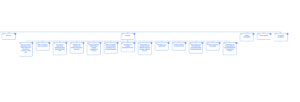HTML Sitemap vs. XML Sitemap: What’s the Difference?
If you’re thinking of redesigning your website this year, you’ve probably been reading up on companies and their procedures as well as the various phases and elements that make up a good website. We are here to discuss two tiny deliverables that have a big impact: sitemaps.
However, did you realise that there are two very distinct meanings for the word “sitemap”?
1. An HTML or visual sitemap
2. An XML sitemap
Both are crucial to the planning and comprehension of your website. We use both in the process of designing websites. Furthermore, you cannot replace one with the other!
Let’s examine the functions of each kind of sitemap and how they affect SEO, user experience, and even Google’s ability to find your material.
Since HTML sitemaps are our fave, we’ll start there (no offence, XML).
What is a visual sitemap, or HTML sitemap?
An easy-to-read two-dimensional text or visual representation of the pages and flow of your website is called an HTML sitemap. Because you used to make an HTML (hypertext markup language) version of it and upload it to your site as a separate page in the early days of the internet, it is named HTML.
The problem is that people now know how to use menus to traverse websites. Sitemaps are rarely found in the footer menu these days, unless the website is quite old. Alternatively, out-of-date businesses that are ignorant about sitemaps submit one that is exactly identical to their main menu, giving users a confusing experience.
Internal teams are now far more likely to adopt the visual format for content strategy that was once known as the HTML sitemap.
We like to say that a visual sitemap is like looking down on the forest while flying over it. This style is a great way to see all of your pages and posts at once, including hidden content, without having to click your way through using menus and buttons while trying to imagine where you’re at in the grand scheme of things.
The styles of sitemaps will vary among firms and designers. It might be a list of pages or a spreadsheet with links and brief descriptions, along with information on who is in charge of the content management system and SEO objectives.
Every website redesign project at STAXO begins with the creation of visual sitemaps, which serve as an information architecture planning tool.
This facilitates our ability to work together with our clients to make sure that every piece of material they have (and require) has a clear strategy for its future. It also aids in the creation of content relationships, the hierarchy of material for primary and secondary audiences, and the best routes through the website.
Furthermore, visual sitemaps provide UI and UX designers with a far stronger foundation around which to build their online designs. Without a blueprint, you wouldn’t begin building a new home’s walls, is that right?
How can I make a text, HTML, or visual sitemap?
The kind of sitemap you wish to utilize will determine which tool you use to produce it.
Text-based sitemaps can be created with common office software, such as Google Sheets and Docs. To obtain a comprehensive list of all the URLs, simply crawl your website. Afterwards, begin grouping the URLs into buckets. Screaming Frog is what we use, although the free edition only scans 500 URLs. Try one of the free web crawlers listed in this Octoparse post if your website is larger.
A little-known trick is that you can plot and update your visual, text, or HTML sitemap by exporting your current XML sitemap as a list.
You’ll need a user-friendly design tool (or a designer) for visual sitemaps.
We use Octopus to generate ours.

Visual sitemap templates are available from well-known platforms like Canva, and Figma.
You can use any number of programmes to assist you build the code for an HTML sitemap that you can then submit to your website.
Is an HTML sitemap necessary?
For an already-existing website, uploading an HTML sitemap is not required. This kind of sitemap seldom offers anything useful that search engines can’t obtain from an XML sitemap, unless it’s done exceptionally well. Furthermore, your audience REALLY shouldn’t require a map to locate content if your UX design is strong.
Whether you’re planning a website redesign, a content audit, a rebranding, or any other significant change to content and structure, creating a text or visual sitemap for internal teams to utilise will greatly improve your user experience and search engine optimisation.
An XML sitemap: what is it?
A file called an XML sitemap is posted to your website and contains a list of all the pages, posts, media, and even taxonomies (such as categories and tags) in a format that search engines can understand.
Its goal is to facilitate more effective crawling by search engines so they can better comprehend your website and find all of its information. Giving Google’s bots a map to all that riches sounds like a no-brainer, since every time they crawl your website, you have the chance to raise your rating!
How are XML sitemaps used by search engines?
Bots from search engines will utilise a sitemap they locate on your website to navigate your material, comprehend its organisation, and determine how important it is in relation to other information.
The developer documentation from Google provides the clearest explanation: “Search engines like Google read this file to crawl your site more efficiently. A sitemap tells Google which pages and files you think are important in your site, and also provides valuable information about these files. For example, when the page was last updated and any alternate language versions of the page.”
Is an XML sitemap necessary?
Moreover, internal and external links—which point to your own pages via buttons, menus, and linked text—allow search engines to index and explore your website. You might get away without it if your website is little and your internal linking is strong.
However, if you don’t have a sitemap, the bots will have to search for your material and comprehend it sufficiently to determine your relevance and assign you a fair ranking. Similar to humans, bots can become irritated and quit if something isn’t clear.
An XML sitemap is what I advise if your website is brand-new and has very few external links, is very big, or has a lot of media files that are indexed.
What is my XML sitemap location?
You may be unaware that you have an XML sitemap already!
Sitemaps are easily readable by humans, even if they are coded for search engines. When a website has an XML sitemap, it is often located at a URL that ends in /sitemap.xml or a similar format.
How can I make a sitemap in XML format?
Our sitemap illustrates that it is produced automatically by the WordPress Yoast SEO plugin. Yoast automatically modifies the sitemap whenever we add, remove, or alter material.
One of the simplest things you can do to improve your SEO is this. You can just download and activate Yoast, it will take care of the rest.
If your website isn’t using WordPress, you can manually construct an XML sitemap and have a developer submit it.
Why is a sitemap important?
The reasons have previously been extensively discussed, so let’s review:
- Text/visual sitemaps are fantastic strategic planning tools
- They make it easy to ensure all content is a part of your plan
- They help you create a great user experience, and even SEO considerations
- If you have a huge, complex website, HTML sitemaps can be a helpful visual wayfinding aid for clients – but in most cases you can accomplish the same thing with a strong UX design and information architecture
- XML sitemaps help search engines efficiently crawl your site
- They make sure nothing gets missed on a crawl
- They help the search engine learn context and importance, which aid in ranking
Does sitemaps matter for SEO?
- Visual, text, or HTML sitemaps help you plan a strong user experience, which indirectly impacts your ranking in multiple ways like positive on-page behaviour, dwell time and time on site, repeat visits, and more
- They help you avoid technical errors from forgotten or deleted content, and orphaned pages
- They help you strategize your keywords at both a high level and for individual content
- XML sitemaps tell search engines exactly how much content you have, where to find it, and how it fits into your site’s structure (plus, they show that you have a strong site structure, which Google loves)
- They show search engines the last date content was modified, which is a vital step toward demonstrating that your content is fresh and should rank well
- You can manually submit your XML sitemap to Google when you’ve updated your content, rather than waiting weeks or even months for its next visit to your site
Google will visit your website more frequently if you consistently add fresh content and update existing stuff.
What happens if you rarely need to update your website? Or what if you don’t want to wait because you just published a fantastic article? Using Google Search Console, you can manually submit your XML sitemap after making modifications.
You now possess all the necessary knowledge regarding sitemaps and how to include both types into your digital strategy. Please contact us if you have any digital marketing related questions.

